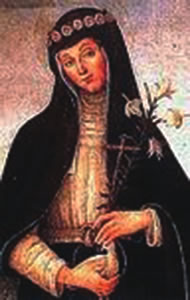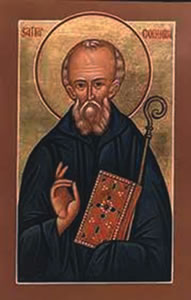June Saints
 Saint Rafael Guizar Valencia (1878-1938)
Saint Rafael Guizar Valencia (1878-1938)
St Rafael Guizar Valencia was born in Cotija, Mexico in 1878 to wealthy and devout parents. After a good education, Rafael entered the seminary and was ordained priest in 1901. An evangelist at heart, he began to move around Mexico giving missions and founded the Missionaries of Our Lady of Hope in 1903. He was appointed apostolic missionary in 1905 and established two colleges for boys and a school for poor girls.
The year 1911 saw an outbreak of persecution against the Catholic Church. Rafael’s missionary congregation was wiped out and his career as missionary preacher officially cancelled. Unofficially, he kept up his work, setting up a press and starting a Catholic periodical which was quickly shut down by the revolutionaries. Undaunted, he accompanied the armies of the revolution in disguise, as a hardware peddler, or a homeopathic physician, or an accordion player, ministering to the wounded and preaching whenever opportunity offered. Increasingly enraged by his ‘guerilla’ activities, the revolutionists several times condemned him to death. In 1916, feeling it wiser to leave the country, Rafael worked in Guatemala for a year under an assumed name, then spent two years in Cuba.
He was still in that country when, in 1919, he was appointed Bishop of Veracruz, Mexico, being ordained Bishop in January 1920. Almost immediately a strong earthquake devastated his diocese so relief work was added to the task of re-evangelising his new flock. The persecution of the Church intensified. When Bishop Rafael re-opened his diocesan seminary, the government shut it down. So Rafael simply relocated it in Mexico City, underground. When the persecution finally stopped, the diocese had more priests than ever.
In 1931, Governor Tejada of Veracruz decreed that only one priest would be permitted for each 100,000 Catholics. The Bishop countered with a non-violent protest – he closed all his churches. Tejada thereupon ordered that he be shot on sight. On learning this, Rafael strode into the Governor’s office. He respected authority, he told Tejada, but wished to spare the Governor’s assistants the trouble of shooting him. Boldness won out. Governor Tejada did not dare to personally execute the Bishop, so he was allowed to remain free. The persecution did not end till 1940.
Bishop Rafael died in 1938, having spent nine of his eighteen years as Bishop in exile or incognito.
Saint Rafael, set us afire with zeal for God and the faith.
(Source: Internet – various)
Saint Columba was born at Gartan, Ireland, around 521. Following his theological studies, he spent fifteen years preaching and founding churches in various parts of Ireland. Then, for some reason he decided to leave his homeland. On Whitsun Eve 563 he landed with twelve companions on the island of Iona and there founded a famous monastery.
From there he preached the gospel in Scotland and revisited Ireland from time to time. People of all kinds from all parts came to consult him at Iona; his influence dominated the Church of Scotland, Ireland and Northumbria, and his monastic rule influenced western Europe for long after his death in 597.
Saint Columba, enlighten us to take the faith to others in our world.
(Source: A New Dictionary of the Saints, Donald Attwater. 1993 Burns & Oates, Kent)
 Saint Mary of Oignies (1167-1213
Saint Mary of Oignies (1167-1213
Mary of Oignies was born in the diocese of Liege in Belgium in 1167, of very wealthy parents. But while still very young, she rejected everything childish or vain. At the age of fourteen she was obliged to marry a virtuous young lord. Her holy life decided him to follow her example; together they resolved to practice continence for life, to distribute their wealth to the poor and consecrate themselves to works of piety.
Mary had the gift of tears, and could not look at a crucifix without breaking into a torrent of tears or being ravished in ecstasy. She had a great devotion to Saint John the Evangelist and conversed with him as well as with her Guardian Angel. She could read hearts and converted many, obtaining graces by her prayers for the living and especially for the dead, for whom she offered prayers and sacrifices, and suffered various illnesses with invincible patience. Her many visitors made a life of contemplation difficult, so she decided to change her residence; her husband permitted her to go to Oignies, where she lived in retreat till her death in 1213.
Saint Mary, teach us to live always conscious of the presence of God.
(Source: http://www.magnificat.ca/cal/engl/06-23.htm)


 Entries(RSS)
Entries(RSS)